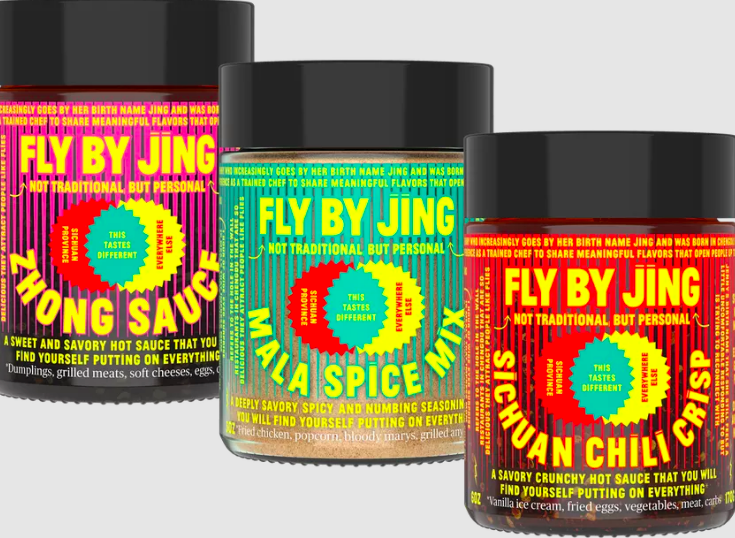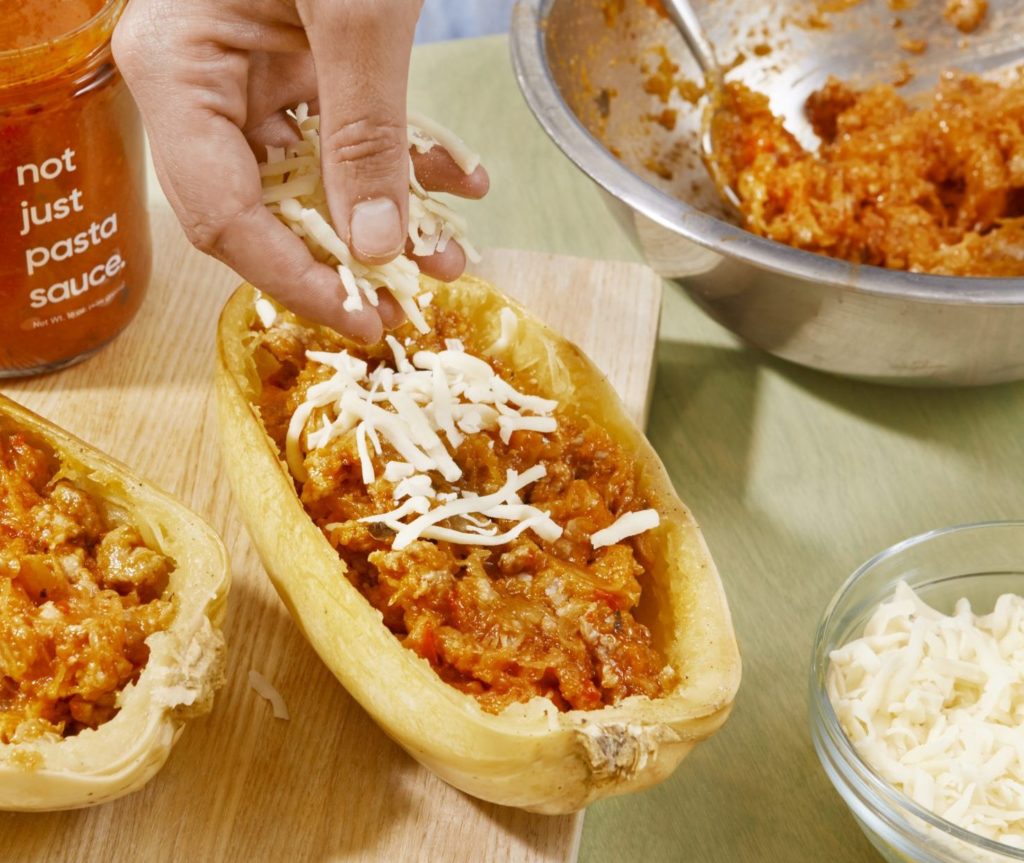

Thanks to Jing Gao, and her company Fly by Jing, anyone, anywhere, can crack open a bottle, and experience some of the magic of Sichuan cuisine.
Sprinkle Fly By Jing Mala Spice Mix on popcorn, smash up cucumbers with the Zhong Sauce, and drizzle eggs with Chili Crisp like Sam Sifton Does.


I once read that “Becoming a mother is like discovering the existence of a strange new room in the house where you already live.” I think it’s a perfect quote. It’s also the best description of how I felt the first time I ate Sichuan food, in my early twenties. A numbing, tingling, spicy, umami explosion; my tongue was getting flavors I didn’t know it could taste. Hitting tastebuds I didn’t know I had! I started looking around the mostly empty suburban restaurant like I was an alien, or a caricature of someone on hallucinogenics: like, “Is this real life?!” I thought I loved food, until I tried Dan Dan noodles topped with crispy bits of ground pork, dumplings slicked in fire-engine red chili oil, and Ma Po tofu that melted in my mouth and burned and soothed me at the same time, leaving me absolutely frantic for more. I became an instant convert, and a fervent evangelist of the cuisine. Had Fly By Jing existed back then, I probably would have tracked down Jing herself and begged for a job.
These days, I’m sorry to admit I’m less susceptible to this kind wild enthusiasm — I suspect it’s some combination of time spent in the wonderfully exhausting room of motherhood, running a startup, and inching towards middle age — but I haven’t hardened one bit when it comes to my dreamy, effusive feelings toward the food of Sichuan. While overly romanticized food writing makes me cringe a little (we get it, the noodles were ethereal, the crème brulee was shatteringly crisp, YAWN), I still get damn near emotional when I recall that baptism by chili-oil in a strip mall in Tewksbury.
In the decade plus since, Sichuan cuisine has become more ubiquitous, but the chefs and cooks who make it, and the folks who grew up eating it still don’t get the credit or spotlight they deserve.
It’s an open secret that I write this column because I love talking with interesting, ambitious folks and sharing it, and because it’s a great excuse to get free advice from founders I admire. There is a lot to learn from Jing. Not only because her products are objectively some of the tastiest condiments on the market, but because she was brave and vulnerable enough to put her whole self, and her journey towards discovering her identity out there, even when it might be risky on levels I’ll never truly understand. I’m grateful she took the time to share some of her story with me, and grateful for her Chili Crisp, Zhong sauce, and Mala seasoning. It all reminds me why I built a life around food in the first place.
This interview has been edited and condensed for clarity
CS: Let’s talk about Sichuan food. The first time I tried it I was blown away. I just had never experienced that magnitude of flavor. It literally gave me a body high. And I would love to know, as someone who is so much more intimately connected with the cuisine, what do you think it is that makes it so special?
JG: Sichuan is a really beautiful region in China and because of the climate there, there’s a huge abundance, and it was along the Silk Road so there is a lot of influence coming in and out that make it a very dynamic cuisine.
Traditional Chinese Medicine has always been a very integral part of how you eat, and because the climate in Sichuan is really humid, people are constantly looking for foods that are thought to fight humidity; heating foods so you can sweat out internal dampness. Ginger and spices were always considered very important, and then when chili peppers came around it was the perfect thing for the weather. Then you add in the Sichuan pepper, which has a numbing effect and used to only be used for medicinal purposes. People discovered it matches really well with the chili pepper because when your mouth is a little numb, you can eat more spicy food, and that combination is addictive.
CS: It’s out of control that Mala numbing hot combo!
JG: Sichuan culture is all about leisure and just enjoying life, and taking things slowly, so the food and drink is really, really sophisticated. It’s all about pleasure, right? Whether it’s drinking tea, playing Mahjong, or just chatting in the park, it’s all about the quality of life, and that’s reflected in the way that people view food. It’s not for sustenance, it’s for enjoyment. It’s all about textures and smells and fragrance and the way it looks, and most importantly, the flavors. There are more than 20 different flavor profiles that you can create with a limited number of ingredients, and all of the flavor profiles are really, really distinct. Flavor trumps everything in Sichuan.
CS: You’ve talked about returning to the name Jing, after many years of going by the name Jenny, Can you talk a little bit about that connection between your food evolution and the evolution of your personal identity?
JG: I was born in Chengdu. I grew up moving around a lot. And in my twenties when I went to Asia for work, that’s when I really realized how disconnected I’d been from my cultural identity, and I tried to dig deeper and was doing so through food. After having gone by a name that I adopted growing up in order to blend in and better kind of conform to other’s expectations, I was like, “actually, I don’t need to do that anymore.” And then we did our rebrand and so, it kind of all happened in parallel. My investigation of Chinese food, culture, my interest in shining a light on it, was really driven by my personal desire to first to get to know myself. Which then led me to realizing just how much it is misunderstood by everyone else.
CS: You say it’s “Food that’s not traditional, but personal.”
JG: When we first launched it, and this was expected, people wanted to compare us to other things. On this journey I realized that what we’re here to do is actually to defy that, the temptation for people to put us in a box. The greater mission of what we’re here to do is create space for more diverse voices to exist, because they deserve to exist. Asian food, or any kind of food, is not a monolith.
CS: Obviously, systemic racism and all of the issues of discrimination toward the AAPI community are not new, but this is a moment when we are finally having a national conversation about it. You’ve been telling your story publicly for more than a year now, does any of this effect how you think about your work?
JG: I think that it’s great that people are starting to pay attention because the reason why we exist is because of the kind of the hostility towards our culture, people and food over many years. It’s something we talk about more, but I don’t think it changes the work that we are doing. Last year when we did the rebrand, it was kind of a shift in our attitude. We are creating an example for just being able to exist without having to answer to anybody, without having to conform to anyone’s expectations. So and that continues. What we hope to do is set an example of what it means to be unapologetic. That just by being who we are, we can inspire others to do the same.




